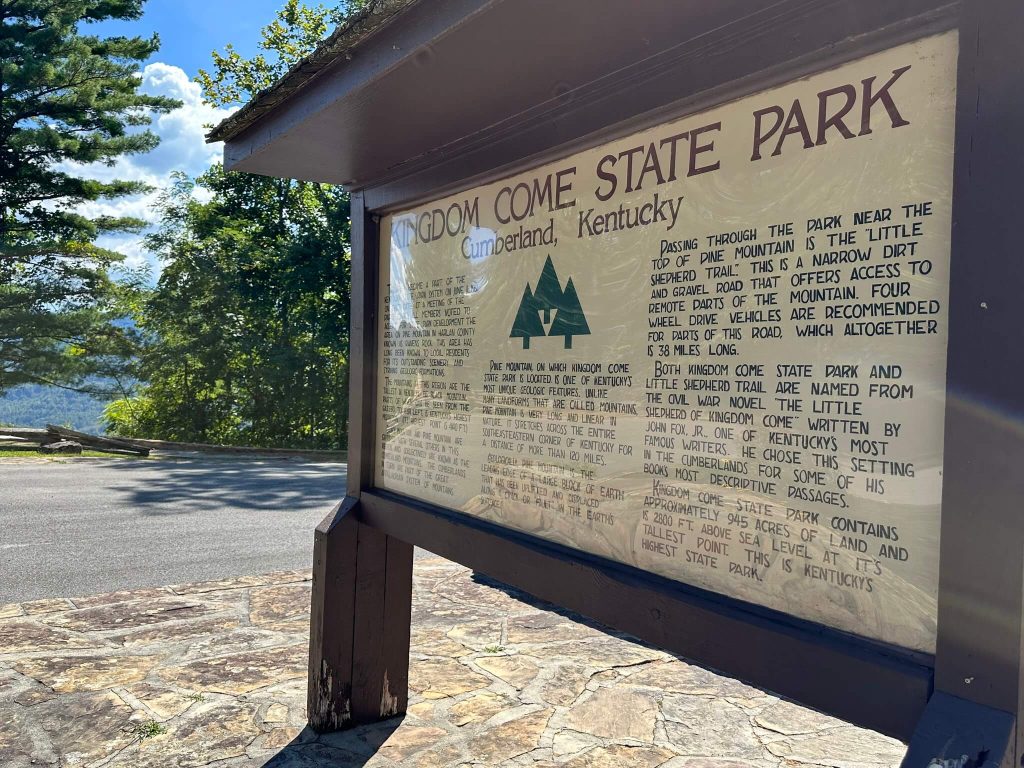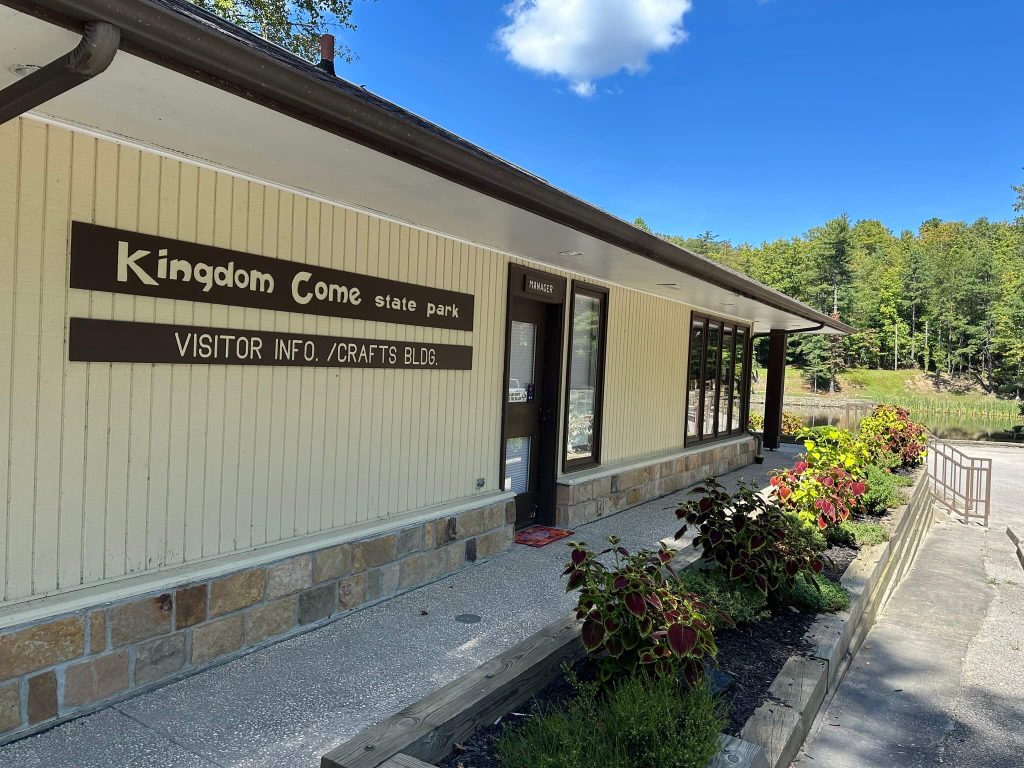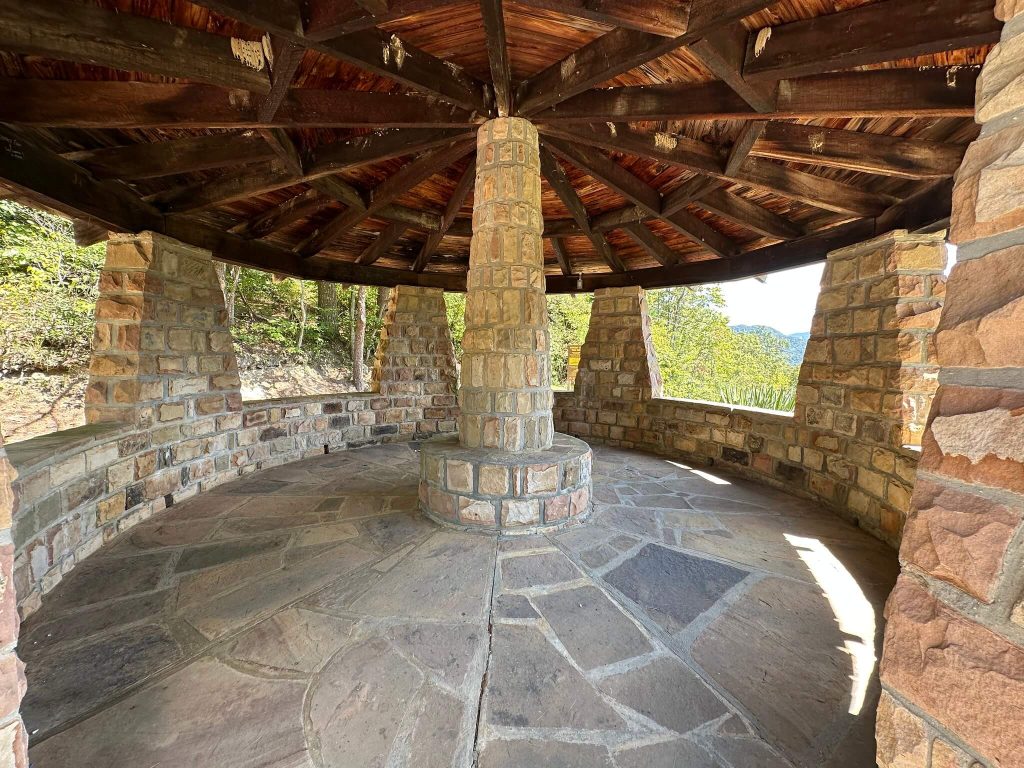Appalachian History Series

High above the coal camps of Cumberland and Benham, a narrow road climbs onto the crest of Pine Mountain and enters a landscape that feels older than the highways that reach it. Kingdom Come State Park is Kentucky’s highest state park, perched around 2,700 feet on the thrust-up backbone of Pine Mountain and protecting roughly 1,283 acres of cliffs, forests, and wind-scoured rock.
Visitors know the place today for Raven Rock, the natural bridge of Log Rock, a small mountain lake, and a growing population of black bears. Yet the park is also a literary landscape, a product of the settlement school movement, a product of fire fighting and road building, and a symbol of Harlan County’s long search for life after coal.
To understand Kingdom Come, you have to read more than the roadside interpretive panels. You have to read a 1903 novel, a state highway marker, board minutes from Frankfort, an old photograph of a man with an axe standing on Log Rock, and the field notes of wildlife biologists tracking bears above the coal camps.
A Novel Makes a Valley Famous
The story of Kingdom Come as a named place does not begin with the park. It begins in print.
In 1903, Kentucky author John Fox Jr. published The Little Shepherd of Kingdom Come, a Civil War novel set in a remote mountain valley called Kingdom Come. The book follows Chad Buford, a poor mountain boy whose loyalties and identity are tested as the region fractures in war. Early pages describe April days of rain, mist, and sudden breaks of sunlight on the mountains, an image that still feels at home on Pine Mountain’s north face.
The novel became a national bestseller. Fox’s mountain romances helped define how early twentieth century Americans imagined “the Kentucky mountains,” for better and for worse, blending local geography with outsider expectations.
A Kentucky Historical Society marker at Linefork in Letcher County later fixed Fox’s fictional landscape to an actual valley. Marker 1294 identifies Kingdom Come as a valley south of Whitesburg, notes that Fox’s novel immortalized the place, and ties the name directly to the later Kingdom Come Settlement School and Kingdom Come State Park.
In other words, the valley came first, the novel carried its name into the wider world, and mid twentieth century institutions borrowed that already charged phrase.
From Valley Name to State Park
By the middle of the twentieth century, Pine Mountain was already important to Kentucky conservationists. It formed a long, rugged wall along the edge of the coalfields, relatively unbroken by roads. As coal production reshaped the valleys below, the ridge itself started to look like a refuge.
On June 11, 1961, the Kentucky Department of Parks Board voted to accept an area of Pine Mountain near Raven Rock as a new state park to be called Kingdom Come State Park. The board’s action formalized a park that would preserve part of the crest above Cumberland and Benham, with a small mountain lake, a ring road to overlooks, picnic shelters, primitive campsites, and eventually a miniature golf course and rental boats.
The choice of name was not accidental. Official state park descriptions explicitly note that the new park was named after Fox’s The Little Shepherd of Kingdom Come, folding a popular Civil War novel into the identity of a modern recreation area.
The Kentucky Geological Survey’s guide to public parks where you can “see geology” points out that Kingdom Come straddles the crest of Pine Mountain, a thrust block of crust that has been shoved up and over another block. Trails and overlooks follow cliffs of Pennsylvanian age conglomeratic sandstone, looking more than a thousand feet down into the Poor Fork and Linefork valleys.
Here, literature, geology, and tourism converged. The park took its name from a fictionalized valley, stood above the real Kingdom Come community, and literally sat on rock that had been pushed miles from its original position.
Skyline Road on the Fire Break: Little Shepherd Trail
Long before most visitors ever saw the park, foresters imagined a road along this ridge.
In December 1958, William “Bill” Hayes, a former Pine Mountain Settlement School student who had become Harlan County’s fire-prevention forester and manager of Kentenia State Forest, wrote to Harlan County Judge Cam Smith to propose a “skyline drive” along the top of Pine Mountain. Hayes had been cutting fire breaks on the ridge and realized that a continuous ridge road could double as both fire access and scenic parkway.
Pine Mountain Settlement School’s account of Hayes reproduces and paraphrases his 1958 letter, describing his dream of a narrow ridge road that would open views into both Harlan and Letcher counties and connect existing forest lands.
Work on the road began in the 1960s. A 1965 ground breaking featured Lieutenant Governor Wilson Wyatt, and contemporary coverage dubbed the developing route “Little Shepherd Trail,” a deliberate nod to Fox’s novel.
Today the Little Shepherd Trail runs for roughly 38 miles along Pine Mountain from near Whitesburg on US 119 to near Harlan on US 421. State and local descriptions emphasize that about 14 miles of the trail pass above Kingdom Come State Park, with primitive camping and water available at the park itself.
The Kentucky Historical Society’s marker listing for the Little Shepherd Trail underscores the literary connection, noting that the road runs through the setting for The Little Shepherd of Kingdom Come, Hell fer Sartain, and The Trail of the Lonesome Pine.
What began as a line on a forester’s fire map became one of eastern Kentucky’s most celebrated scenic drives and the motor route that brings many travelers directly to Kingdom Come State Park’s main gate.

Settlement Schools in the Kingdom Come Valley
Look north or east from the park’s overlooks on a clear day and you can see the roof of a long, stone school building in the valley below. That is Kingdom Come Elementary School, the modern successor to Kingdom Come Settlement School.
Settlement schools were a distinctive Appalachian institution. Inspired by urban settlement houses but adapted for rural mountains, they combined schooling with social work, community programs, and often a strongly religious mission.
KET’s documentary “Settlement Schools of Appalachia” highlights Kingdom Come Settlement School among the network of early twentieth century institutions that sought to “uplift” isolated communities while also preserving, and sometimes curating, mountain culture.
Reference works on settlement schools note that Kingdom Come Settlement School was founded around 1924 in Linefork, Letcher County, under Methodist sponsorship. Jamie in Wanderland, a modern photo blog, traces the building’s history from settlement school to combined elementary and high school, then to an elementary school only after Letcher County consolidated its high schools in the 1960s.
Crucially for our story, Jamie points out that this is the same school whose roof is visible from Kingdom Come State Park’s overlooks, tying the park’s scenic vistas directly to the educational and religious history of the valley.
Oral history clips and reunion ephemera from former Kingdom Come students, scattered across YouTube and social media, add another layer. Alumni remember the school as both demanding and close knit, a place where “we had good teachers” and where settlement era ideals persisted into the age of school buses and paved roads.
From the ridge, the park’s visitors look down on a landscape where the words Kingdom Come have signified a valley, a novel, a mission school, and, eventually, a public elementary school.
Bears Return to Pine Mountain
For much of the twentieth century, black bears were gone from Kentucky. Overhunting and forest loss had pushed them out of the state, though they persisted in rugged parts of neighboring Virginia, West Virginia, Tennessee, and North Carolina.
By the late twentieth century, that began to change. As forests regrew and hunting regulations took hold, bears from those neighboring strongholds started to recolonize the most remote parts of eastern Kentucky.
A 2003 article from the University of Kentucky’s College of Agriculture, titled “Rising Black Bear Population in Kentucky a Good Sign,” reported on research in and around Kingdom Come State Park. Wildlife biologist David Maehr and colleagues used radio collars and field studies to document bears “recolonizing southeast Kentucky,” including the rugged country around the park.
The article cast the new bears as both ecological victory and economic opportunity, suggesting that a healthy bear population signaled “growing appreciation of nature” in the Commonwealth, while also drawing tourists interested in seeing wildlife.
Unger and coauthors’ 2013 peer reviewed study “History and Current Status of the Black Bear in Kentucky” devoted particular attention to Kingdom Come State Park. They noted that black bear viewing at the park had become popular and that Cumberland and surrounding communities were marketing themselves as a kind of bear capital for the state.
With more bears came new conflicts. A 2005 article in Columbia Magazine recounted the story of a female black bear and five cubs at Kingdom Come State Park that became dangerously accustomed to human handouts. Visitors and locals had been feeding the family, leading the bears to raid coolers and campsites and forcing Kentucky Department of Fish and Wildlife officers to intervene.
In response to situations like that, the Kentucky Department of Fish and Wildlife Resources emphasized that feeding black bears, directly or indirectly, is illegal statewide and can carry fines and jail time. Their “Black Bears in Kentucky” guidance outlines how guests in places like Kingdom Come can camp, store food, and behave around bears in ways that protect both people and animals.
In 2005, KET’s Kentucky Life special “Wild and Scenic Kentucky” helped introduce a broader television audience to this new reality. Host Dave Shuffett visited Pine Mountain and featured black bears at Kingdom Come State Park, presenting them as part of a recovering wild Kentucky.
Today, bears are part of the park’s brand, yet they remain wild animals whose presence is the result of a complex history of extirpation, protection, scientific study, and changing public attitudes.
Fire, Bats, and a Protected Ridge
Kingdom Come’s story is not only about charismatic mammals. It is also about fire and bats.
Deep crevices in the park’s Cave Amphitheater and nearby Line Fork Cave provide winter roosting habitat for Indiana bats, a federally endangered species. The Office of Kentucky Nature Preserves notes that historically as many as 10,000 Indiana bats used Line Fork Cave, and that more than 3,000 still hibernate there today.
To protect that colony and its surrounding forest, Kentucky dedicated a 225 acre state nature preserve inside the park on March 4, 1992. The preserve encompasses north facing slopes of Pine Mountain within the park and a segment of the developing Pine Mountain State Scenic Trail.
The same steep slopes that shelter bats also create a serious fire risk. In April 2014, a spring forest fire pushed by strong winds burned hundreds of acres on and near the park. News reports from the Courier-Journal, The Lane Report, and state press releases describe how about 50 Division of Forestry firefighters and local departments worked to contain a blaze that covered roughly 465 acres, about half of it within park boundaries. Roads and the park itself were closed while the fire was controlled.
By mid April, officials announced that Kingdom Come State Park would reopen, although some trails remained closed while crews inspected for hazard trees and damage.
All of this unfolded in a landscape already known for unusual rock. Raven Rock is a sandstone outcrop that leans out from Pine Mountain at roughly a forty five degree angle and rises nearly 290 feet above the slope below. Log Rock, a natural sandstone bridge that resembles a petrified tree, sits along a ridge-top trail in the park.
Early twentieth century visual sources show that Log Rock was a destination long before the state park existed. A University of Louisville photograph, dated around 1900 to 1904, depicts a man with an axe sitting on top of Log Rock on Pine Mountain. The catalog notes that this natural bridge, about eighty feet long, is now within Kingdom Come State Park.
Taken together, the bats, fires, and stone arches reveal Kingdom Come as both a fragile and enduring landscape, continually shaped by natural forces and human decisions.

Cabins, Overlooks, and Life After Coal
For decades, Kingdom Come State Park offered day use facilities, campsites, and a modest campground but no cabins. That began to change in the 2020s.
Local and regional tourism coverage has repeatedly described the park as “the crown jewel” of Pine Mountain, emphasizing its altitude, numerous overlooks, and relative remoteness.
A 2021 “Insider Guide” piece syndicated in the Harlan Enterprise and Claiborne Progress framed Kingdom Come as a destination for sky high views, with fourteen hiking trails crisscrossing nearly five miles of rugged terrain and a ring of scenic overlooks like Bullock, Creech, and 12 O’Clock.
In June 2022, reporter Joe Asher wrote that Kingdom Come State Park had received funding for the construction of cabins and upgraded camping options. Governor Andy Beshear’s comments in that article positioned the park improvements as part of an effort to boost tourism and diversify Harlan County’s economy.
Meanwhile, regional magazines and tourism campaigns increasingly use images from Kingdom Come to symbolize Harlan County’s attempt to “face forward” after coal’s decline. In a 2021 Blue Ridge Country feature, “Harlan, KY Faces Forward,” a photograph from Bullock Overlook at Kingdom Come State Park anchors a story about creativity, community, and the long work of reinventing a coal town.
In this newer phase of the park’s history, cabins and Instagram ready overlooks are not just amenities. They are tools in a larger experiment in rural economic transition, an attempt to trade a reputation built on company towns and strikes for one built on hiking, wildlife, and mountain views.
Reading the Landscape Today
Standing at one of Kingdom Come’s overlooks today, you can read more than the fall colors.
To the north, the roof of Kingdom Come Elementary hints at the settlement school movement and the long institutional life of a valley named in both scripture and fiction.
To the south, the smokestacks, tipples, and museums of the Tri Cities remind you that this ridge was once surrounded by some of the most productive coal camps in the United States, places that are now trying to survive mine closures and bankruptcies.
On the ridge itself, the narrow blacktop of the Little Shepherd Trail carries Hayes’s 1958 dream forward. What began as a fire control project is now part of the Pine Mountain State Scenic Trail corridor, a long distance hiking route that will eventually link Breaks Interstate Park to Cumberland Gap and passes through or near Kingdom Come’s boundaries.
Around you, the forest holds Indiana bats in winter, black bears in summer, and the common ravens that still circle Pine Mountain’s cliffs.
Below your feet, Pennsylvanian sandstone records a geologic history of uplift and erosion older than any company charter or county line.
Kingdom Come State Park is not a pristine wilderness untouched by people. It is a layered cultural landscape where novels, schools, roads, coal, fires, bats, bears, and budget line items all intersect. Reading that landscape seriously helps us see that even our “scenic overlooks” are products of history as much as nature.
Sources and Further Reading
John Fox Jr., The Little Shepherd of Kingdom Come (1903). Public domain text via Project Gutenberg and other archives. Scribd+1
Kentucky Historical Society, Historical Marker 1294, “The Little Shepherd of Kingdom Come,” Kingdom Come valley, Letcher County. Explore Kentucky History+2Explore Kentucky History+2
Kentucky Department of Parks Board action creating Kingdom Come State Park, June 11, 1961, summarized in official centennial materials and park histories. Kentucky State Parks+1
Office of Kentucky Nature Preserves, “Kingdom Come State Park and State Nature Preserve” (dedication March 4, 1992, Indiana bat colony, acreage, and management). Kentucky Energy and Environment Cabinet+1
Pine Mountain Settlement School, “Little Shepherd Trail” and William Hayes biography, reproducing Hayes’s 1958 letter proposing a skyline road. Pine Mountain Settlement School+2Pine Mountain Settlement School+2
University of Louisville Digital Collections, “Log Rock, Pine Mountain. Length: 80′.” Photograph dated circa 1900–1904, now within Kingdom Come State Park. digital.library.louisville.edu+1
UK College of Agriculture, “Rising Black Bear Population in Kentucky a Good Sign” (2003), quoting David Maehr and John Cox on recolonization around Kingdom Come State Park. news.mgcafe.uky.edu+1
D. E. Unger et al., “History and Current Status of the Black Bear in Kentucky,” Northeastern Naturalist 20 (2013). BioOne+1
ColumbiaMagazine.com, “Feeding bears creates problems and may get you a ticket” (2005), on food conditioned bears at Kingdom Come State Park. columbiamagazine.com
Kentucky Department of Fish and Wildlife Resources, “Black Bears in Kentucky” and related guidance. Kentucky Fish and Wildlife+1
KET, Kentucky Life special, “Wild and Scenic Kentucky” (2005), featuring black bears at Kingdom Come State Park. PBS+1
Courier Journal, Lane Report, and Associated Press coverage of the April 2014 forest fire and temporary closure of Kingdom Come State Park. Kentucky+3Courier Journal+3Lane Report+3
Joe Asher, “Cabins coming to Kingdom Come State Park,” Harlan Enterprise (June 10, 2022). Harlan Enterprise+1
Jamie in Wanderland, “Kingdom Come Settlement School — Letcher County, Kentucky” (2015), with photos and historical summary. Jamie in Wanderland+1
Kentucky Department of Parks, “Explore | Kingdom Come State Park” and main park page. Kentucky State Parks+2Kentucky State Parks+2
Harlan County Tourism, “Kingdom Come State Park” and related trail and overlook descriptions. Harlan County+2KISS 106+2
Kentucky Geological Survey, “Public Parks in Kentucky Where You Can See Geology” (Kingdom Come section) for Pine Mountain thrust and sandstone cliffs. University of Kentucky
Office of Kentucky Nature Preserves and Pine Mountain State Scenic Trail overview for broader trail corridor context. Kentucky Energy and Environment Cabinet+2Kentucky Energy and Environment Cabinet+2
KET, “Settlement Schools of Appalachia” and scholarly work on settlement schools for background on Kingdom Come Settlement School. education.ket.org+2Wikipedia+2
Blue Ridge Country, “Harlan, KY Faces Forward” (2021), using Bullock Overlook at Kingdom Come State Park as a visual anchor for Harlan County’s post coal transitions. Blue Ridge Country+1